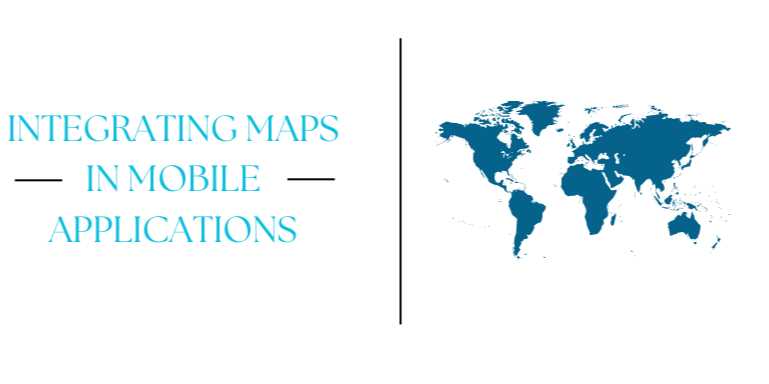Integrating Maps in Mobile Applications

📘 Chapter 6: Security, Privacy, and Store Compliance
🔍 Overview
Map integrations aren’t just about markers and
directions—they also collect, store, and process sensitive data like GPS
location, travel history, and user preferences. Mishandling
this data can lead to legal consequences, app store rejections, or worse—loss
of user trust.
This chapter walks you through:
- Securing
location data in transit and at rest
- Implementing
privacy-first location handling
- Complying
with Google Play and Apple App Store requirements
- Navigating
global data laws like GDPR and CCPA
- Auditing
permissions, settings, and third-party SDKs
🔐 1. Understanding
Security Risks in Map Applications
Location-based apps are vulnerable to:
|
Risk Type |
Description |
|
Unauthorized Access |
GPS data accessible
without consent |
|
Data Leaks |
Unencrypted
storage or transmission |
|
Improper Usage |
Using location for
analytics/ads without informing user |
|
Third-Party Leakage |
Data shared
with SDKs or APIs not governed by your policy |
✅ 2. Secure Location Data
Handling
🔸 In Transit (Network)
- Use HTTPS/TLS
for all API calls involving location data
- Never
send raw GPS data via unencrypted or unsecured APIs
- Avoid
storing coordinates in GET query strings—use POST with body
🔸 At Rest (Storage)
- Encrypt
stored coordinates using AES-256
- Avoid
logging exact GPS coordinates unless absolutely needed
- Anonymize
or hash frequent location patterns
- Use
device-native secure storage (Keychain, EncryptedSharedPreferences)
✅ Android Example: Secure
Location Storage
kotlin
val
encryptedPrefs = EncryptedSharedPreferences.create(
context,
"secure_location_prefs",
MasterKey.Builder(context).setKeyScheme(MasterKey.KeyScheme.AES256_GCM).build(),
EncryptedSharedPreferences.PrefKeyEncryptionScheme.AES256_SIV,
EncryptedSharedPreferences.PrefValueEncryptionScheme.AES256_GCM
)
encryptedPrefs.edit().putString("last_location",
"37.7749,-122.4194").apply()
✅ iOS Example: Secure Storage
with Keychain
swift
let
query: [String: Any] = [
kSecClass as String:
kSecClassGenericPassword,
kSecAttrAccount as String:
"user_location",
kSecValueData as String:
"37.7749,-122.4194".data(using: .utf8)!
]
SecItemAdd(query
as CFDictionary, nil)
👁️ 3. Privacy-First
Design
Design your location features around user transparency
and control.
🔹 Best Practices:
- Ask
for permissions just-in-time, not at app launch
- Explain
why location access is needed before triggering system prompt
- Offer
fallback workflows for users who deny permissions
- Allow
users to delete or reset stored location data
- Display
a settings page to adjust location preferences
📌 Sample Permission
Rationale
“To show nearby restaurants, we need your location. You can
revoke this anytime in Settings.”
📱 4. App Store Guidelines
for Location Permissions
✅ Apple App Store
|
Requirement |
Implementation |
|
Justify permission
in Info.plist |
Use
NSLocationWhenInUseUsageDescription or NSLocationAlwaysUsageDescription |
|
App Tracking Transparency (ATT) |
Required for
apps using IDFA or third-party SDKs |
|
Background location
access |
Must explain clearly
and get separate approval |
✅ Google Play Store
|
Requirement |
Implementation |
|
Declare location
access in manifest |
ACCESS_FINE_LOCATION,
ACCESS_BACKGROUND_LOCATION |
|
Complete Data Safety Form |
Detail how
and why location is used |
|
Include Privacy Policy
URL |
Must mention location
handling practices |
🛡️ 5. Compliance with
Data Protection Laws
✅ GDPR (Europe)
- Request
explicit user consent before collecting location
- Store
data only as long as necessary
- Provide
right to be forgotten (data deletion upon request)
- Maintain
logs of when data was accessed and by whom
✅ CCPA (California)
- Inform
users of what location data is collected
- Allow
users to opt-out of sale or sharing of data
- Disclose
third-party SDKs using location
🧪 6. Auditing and
Permission Hygiene
|
Audit Area |
What to Check |
|
Permissions List |
Only request what you
need (avoid ACCESS_BACKGROUND unless required) |
|
SDK Usage |
Audit
third-party SDKs (ads, analytics) for location access |
|
Storage Hygiene |
Delete location data
after use or on logout |
|
Crash/Error Logs |
Ensure they
don’t contain sensitive coordinates |
⚠️ 7. Common Security Pitfalls
to Avoid
|
Mistake |
Risk |
|
Hardcoding location
APIs |
Can expose your
endpoints to scraping |
|
Storing raw coordinates in logs |
May expose sensitive
movement history |
|
Sending location
data to multiple endpoints |
Increases risk of
breach |
|
Accessing location in background without consent |
Violates
platform policy |
🧩 8. Secure Consent
Workflows
|
Action |
Implementation
Strategy |
|
Ask for location
only on use |
Button-triggered
request, not at app launch |
|
Pre-permission explanation |
Use
modal/dialog explaining use before system prompt appears |
|
Allow manual input
alternative |
Let users type their
location if permission denied |
|
Provide revocation UI |
Add a “Reset
Location Preferences” option in settings |
📋 Summary Table: Secure
Location Integration Checklist
|
Task |
Android |
iOS |
|
Secure transmission |
HTTPS only |
HTTPS only |
|
User permission prompt |
Contextual +
rationale |
Contextual + Info.plist
strings |
|
Location revocation
handling |
Detect & offer
fallback |
Detect & offer
fallback |
|
Background usage justification |
Manifest +
Play form |
Info.plist +
App Review note |
|
Storage security |
EncryptedSharedPreferences |
Keychain |
|
SDK audit |
Manual + static
scan |
Manual + App
Privacy Report |
|
Privacy policy URL |
Required |
Required |
📌 Conclusion
Respecting user location data is not just a legal
requirement—it’s an ethical responsibility. Implementing security best
practices and privacy-by-design ensures your app builds trust, avoids store
rejections, and stays compliant with global regulations.
Your map-powered app should empower users, not track them
silently. With encrypted storage, clear permission flows, and proper SDK
auditing, you’ll stand out as a developer who cares about user rights.
FAQs
❓1. What are the most popular APIs or SDKs for integrating maps in mobile apps?
Answer:
The most popular options are:
- Google
Maps SDK for Android and iOS
- Apple
MapKit (iOS/macOS)
- Mapbox
SDK (cross-platform)
- HERE
SDK
- OpenStreetMap
(with third-party libraries)
Each offers unique features such as offline maps, customizable styles, routing, and geofencing.
❓2. Do I need an API key to use Google Maps in my app?
Answer:
Yes. You must create a Google Cloud Platform project, enable the Maps SDK, and
generate an API key. This key must be included in your app's configuration and
is used to monitor usage and billing.
❓3. Can I use maps in both Android and iOS using a single codebase?
Answer:
Yes. Frameworks like Flutter (google_maps_flutter), React Native
(react-native-maps), and Ionic/Capacitor allow you to integrate maps
across both platforms using a single codebase while still accessing native
performance and features.
❓4. How can I track a user’s real-time location?
Answer:
Use location services like:
- FusedLocationProviderClient
(Android)
- CLLocationManager
(iOS)
- Geolocator
(Flutter) These services provide GPS-based updates which can be fed into
your map widget to reflect movement in real time.
❓5. How do I handle location permission requests correctly?
Answer:
- Always
request permissions contextually (i.e., when the feature is needed)
- Use
pre-permission prompts to explain why the location is needed
- Implement
graceful fallbacks when permissions are denied
- Follow
platform-specific guidelines (ACCESS_FINE_LOCATION,
NSLocationWhenInUseUsageDescription, etc.)
❓6. What’s the difference between MapKit and Google Maps SDK?
Answer:
MapKit is Apple’s native mapping framework with seamless iOS
integration, while Google Maps SDK offers more advanced features like
street view, better global coverage, and dynamic routing. Google Maps is
preferred for cross-platform apps, while MapKit is great for iOS-only apps.
❓7. Can I create custom map markers and popups?
Answer:
Yes. All major SDKs (Google Maps, MapKit, Mapbox) support:
- Custom
icons/images for markers
- Info
windows/popups
- Click
or long-press events for user interaction
This allows you to personalize map interactions and branding.
❓8. Are offline maps possible?
Answer:
Yes, but not all SDKs support them by default. Mapbox, HERE Maps,
and Google Maps (via caching) allow for offline functionality, often
with a file size and usage limit. Offline maps are useful in areas with poor
connectivity.
❓9. How can I show directions or routes between two points?
Answer:
Use services like:
- Google
Maps Directions API
- MapKit’s
MKDirections
- Mapbox
Navigation SDK
These provide polyline paths, distance, estimated time, and navigation instructions between locations.
❓10. What privacy considerations should I follow while integrating maps?
Answer:
- Inform
users before collecting or using location data
- Request
the minimum necessary permissions
- Anonymize
or encrypt stored location data
- Clearly
outline usage in your Privacy Policy
- Follow
GDPR, CCPA, and platform-specific policies like Apple’s App Tracking
Transparency (ATT)
Tutorials are for educational purposes only, with no guarantees of comprehensiveness or error-free content; TuteeHUB disclaims liability for outcomes from reliance on the materials, recommending verification with official sources for critical applications.
Explore Other Libraries
Related Searches
Please allow ads on our site
Kindly log in to use this feature. We’ll take you to the login page automatically.
Login
Join Our Community Today
Ready to take your education and career to the next level? Register today and join our growing community of learners and professionals.

Your experience on this site will be improved by allowing cookies. Read Cookie Policy
Your experience on this site will be improved by allowing cookies. Read Cookie Policy

Comments(0)